This is a small flake fracture on one of the bones in your hand
Healing
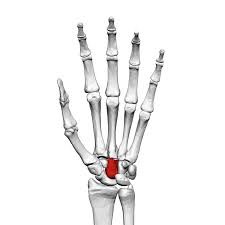
It normally takes 6 weeks to heal, but symptoms can continue for 3-6 months. For the first 3 weeks, the wrist is likely to be treated with a cast or a splint.
Smoking will slow down your healing. We would advise that you stop smoking while your fracture heals. Talk to your GP or go to www.smokefree.nhs.uk for more information.
Pain and Swelling
Painkillers are important to aid your recovery and should be used as required. Stop non-steroidal anti-inflammatory drugs (NSAIDS) e.g. Ibuprofen after 5-7 days as this will slow bone healing. You may find it continues to be a bit achy and swollen for a few months after your injury. An ice pack will help initially with pain and swelling (make sure the ice is not in direct contact with the skin).
Splint/Strapping
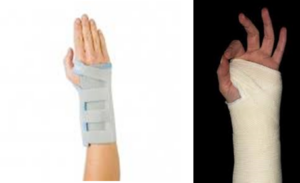
You should wear the splint / plaster cast for 3 weeks.
Follow up
A follow up appointment is not normally needed for this injury. Please contact the Virtual Fracture Clinic if after 6 weeks you still have significant pain or swelling.
Caring for your injury: Week by Week
0 – 2 weeks since injury
- √ – You will have a below elbow plaster cast or wrist
support/splint - √ – Move your fingers gently to prevent stiffness – See initial exercises below
- √ – Cradle your arm around your waist if walking long distances and elevate regularly to help manage swelling
3-6 weeks since injury
- √ – Remove cast/splint – see information below on how to do this
- √ – Start to do range of movement exercises (as detailed later in this page)
- √ – You can use your injured hand for light tasks as pain allows
- X – Avoid heavy lifting tasks and contact sports
6-12 weeks since injury
- √ – The injury has healed. Swelling however can last for several months
- √ – Heavy lifting could be painful for up to 8 weeks. Increase gradually using pain as a guide.
8+ weeks since injury
- X – if you are still experiencing significant pain and swelling then please contact the Virtual Fracture Clinic for advice
Caring for your injury: Splinting/Cast
Plaster Cast:
You may have been given a plaster of paris cast instead of a splint.
If you have any of the following please contact the plaster room.
- Any new pain unrelated to your existing injury e.g. persistent burning sensation under the cast
- Soreness or rubbing of the cast
- Any offensive smells from the cast
- Staining or leaking through the cast from a wound discharge
- The cast become broken, soft, dented or loose
- The cast becomes wet
The plaster cast needs to be on for 3 weeks. This can then be removed at home. For further advice on removal of the plaster cast at home please watch the video created by the British Society for Children’s Orthopaedic Surgery.
If you need further advice about removing the plaster cast please contact the Virtual Fracture Clinic.
Caring for your injury: Initial exercises
It is important to start finger exercises straight away to prevent stiffness. You will find pictures and instructions for your exercises below. Use your hand for light tasks within the limitations of pain. This will not cause further damage but failure to do so may lead to ongoing stiffness.
The following exercises should be performed slowly and regularly every day. The purpose of these exercises is to prevent stiffness in.
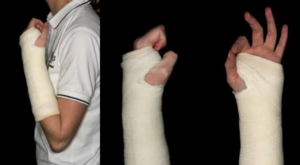
Bend / straighten elbow. Touch fingers with thumb. Try and make a full fist.
To be practiced every 2-3 hours.
Caring for your injury: From 3 weeks – Additional Exercises
Movement Exercises on removal of plaster/splint
It is important to start gentle wrist exercises straight away once your plaster is removed to prevent stiffness. You will find pictures and instructions for your exercises below. Use your hand as normally as possible within the limitations of pain. This will not cause further damage but failure to do so may lead to on-going stiffness.
The following exercises should be performed slowly and regularly every 2-3 hours holding each stretch for 5-10 seconds. You can now use your other hand to add gentle pressure at the end of movement, but do not force movement.
Little and often (a few of each exercise every 2-3 hours) is better that doing lots of repetitions.
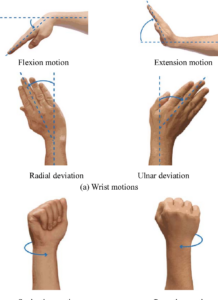
Strength
You can do some simple exercises to help increase strength. Practice up to 3 times a day starting with 5 repetitions, increasing to 10 as able.
Use an elastic band around your fingers to strengthen the muscles in the hand.
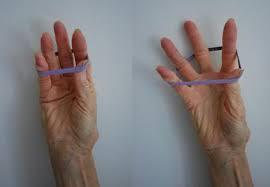
Using a light weight (1/2 – 1kg), place your wrist over the edge of the table and practice wrist flexion and extension.

Using a light weight (1/2 – 1kg), place wrist over the edge of the table palm forward and then turn arm with palm up
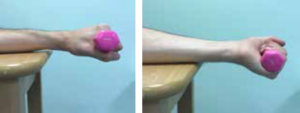
Using a light weight (1/2 – 1kg), place wrist over the edge of the table and on it’s side. Tilt wrist up and down.

Using a light theraband, hold it with your injured hand and move the wrist down and up using the theraband to resist the movement. Also, with your wrist on its side, tilt wrist up and down using the theraband to provide some resistance.

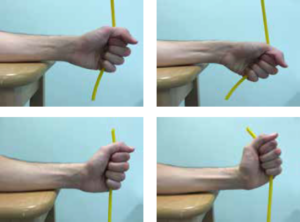
Frequently Asked Questions
I’m concerned about my symptoms and/or I am struggling to return to exercise.
Please contact the Virtual Fracture Clinic.
I am struggling with my strapping/splint. What do I do?
Contact the Virtual Fracture Clinic. We can give advice or change your splint/cast if needed.
When can I start driving?
You can return to driving when:
- You are not using the splint/strapping/cast
- You can move comfortably
- You can control the vehicle safely
Always test your ability to drive in a safe environment first
How can I get a certificate for work?
You can self-certify for the first 7 days following your injury. For any longer periods, please discuss the provision of a fitness to work statement with the Virtual Fracture Clinic Team or your GP.
How do I contact the Virtual Fracture Clinic?
Call 01582 718121. Messages will be checked every morning Monday-Friday.
Email VFC@ldh.nhs.uk
Contact Details for Bedford and Luton
Please contact the hospital where you attended A&E as the other site will not be able to access your notes
BEDFORD HOSPITAL PATIENTS
How do I contact the Virtual Fracture Clinic (VFC)
- Telephone 01234 792036
- Messages will be checked every morning Monday to Friday (except for Bank Holidays)
- Email VFCBedford@bedfordhospital.nhs.uk
How do I contact the Fracture Clinic?
- Telephone 01234 792138
How do I contact the Plaster Room?
- Telephone 01234 792031
- Monday to Friday 9am to 5pm (out of hours contact the Emergency Department)
LUTON & DUNSTABLE HOSPITAL PATIENTS
How do I contact the Virtual Fracture Clinic (VFC)
- Telephone 01582 718121
- Messages will be checked every morning Monday to Friday (except for Bank Holidays)
- Email VFCLuton@ldh.nhs.uk
How do I contact the Fracture Clinic?
- Telephone 01582 497194 or 01582 718 993 (outpatient appointments)
How do I contact the Plaster Room?
- Telephone 01582 491166 (ext. 2233)
- Monday to Friday 9am to 5pm (out of hours contact the Emergency Department)
